Physical Address
304 North Cardinal St.
Dorchester Center, MA 02124
Many systemic diseases of childhood involve the pulmonary parenchyma. The pulmonary manifestations may in fact prompt the patient or parents to seek medical attention and frequently a chest radiograph is obtained early in the illness. Therefore the radiologist can play an important role in directing the diagnostic workup by recognizing that the pulmonary findings reflect an underlying condition. In some patients, such as those with pulmonary edema or sickle cell disease, the radiograph shows the pulmonary findings adequately to continue appropriate clinical care. In many patients, however, the chest radiograph provides initial clues to the diagnosis but is otherwise nonspecific and prompts further investigation with computed tomography (CT). Techniques such as controlled ventilation inspiratory/expiratory breath-holding (see Chapter 49 ) and more recently available CT volume scans (mitigating the need for sedation) continue to reduce breathing artifacts and thus improve lung parenchymal assessment.
This chapter will discuss several specific systemic diseases affecting the lung as well as the effects of generalized systemic illness on the lung. In addition, it will detail pulmonary injury that occurs following therapy such as hematopietic stem cell transplantation and extrinsic agents including chemotherapy, radiation therapy, inhalation injury, and ingestion of hydrocarbons and mineral oil. Finally, near drowning events and conditions with pulmonary calcifications will be described.
Pediatric patients with pulmonary vasculitis typically present in their teen years. Vasculitides affecting the small vessels are the most likely to cause pulmonary parenchymal disease, and granulomatosis with polyangiitis (GPA, formerly Wegener granulomatosis) and idiopathic pulmonary capillaritis are the most common of these disorders in children. Microscopic polyangiitis (MPA) and eosinophilic granulomatosis with polyangiitis (EGPA, formerly Churg–Strauss syndrome) also involve the lung parenchyma but are rarely seen in children.
GPA typically presents with a triad of necrotizing granulomatous lesions in both the upper and lower respiratory tract, as well as glomerulonephritis. MPA is a nongranulomatous necrotizing vasculitis almost always seen with glomerulonephritis. EGPA typically presents with asthma and blood eosinophilia.
Pulmonary involvement is seen less commonly in children than in adults with collagen vascular diseases (CVDs) such as juvenile arthritis, dermatomyositis, systemic sclerosis (scleroderma), systemic lupus erythematosus (SLE), and mixed connective tissue disease. The highest incidence of pulmonary involvement is seen in children with systemic sclerosis (59%–91%) and it is associated with significant morbidity and mortality rates. Abnormal pulmonary function tests (PFTs) can act as a monitoring tool to identify children who would benefit from further evaluation with high-resolution CT (HRCT). Symptomatic lung disease is significantly less common in juvenile idiopathic arthritis and SLE, reported in only 5% of patients.
Pulmonary hemorrhage may occur in the vasculitides and in CVDs ( e-Fig. 57.1 ) and has high morbidity and mortality rates (50%–90%). Additionally, the vasculitides and CVDs both may cause pulmonary renal syndrome, which is the manifestation of pulmonary hemorrhage and glomerulonephritis. It often occurs in GPA and SLE.
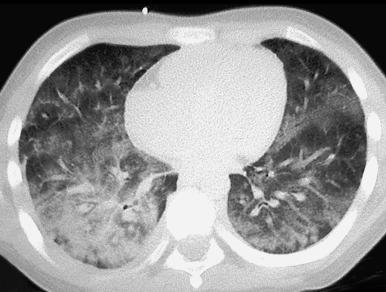
Most of the pulmonary vasculitides are immunologically mediated although up to half of pediatric capillaritis cases are antibody negative. GPA, MPA, and EGPA are associated with antineutrophil cytoplasmic antibodies (ANCAs) and are sometimes referred to as ANCA-associated systemic vasculitides .
Most of the CVDs also have an autoimmune mechanism, SLE being the classic autoimmune condition associated with antinuclear antibody. These disorders are associated with a variable degree of inflammation of multiple organ systems, including the lung. Depending on the specific disorder, patients may present with arthritis, serositis, vasculitis, other soft tissue inflammation, or all of these.
The imaging findings of pulmonary vasculitis and CVDs are summarized in Table 57.1 . The most frequent imaging findings of GPA are variable sized nodules (seen in up to 70% of patients), followed by ground-glass opacities and airspace consolidation; 17% of the nodules showed cavitation in a pediatric population, and up to 50% of nodules are reported to be cavitary in a general population, with higher incidence of cavitation in nodules larger than 2 cm. The nodules are characteristically surrounded by a halo of ground-glass opacity, which represents hemorrhage ( Fig. 57.2 ). Airway wall thickening may also be seen, but airway strictures are significantly less common in children (3%) compared with adults (up to 59%). Diffuse alveolar hemorrhage (occurring in 44% of pediatric GPA) is characterized by lobular or lobar regions of ground-glass opacity or airspace consolidation on CT. It may also show the “crazy paving” pattern on CT, especially as it evolves.
| Nodules (Some Cavitary) | Ground-Glass Opacities | Airspace Opacities | Diffuse Alveolar Hemorrhage * | Interstitial Thickening | Pleural/Pericardial Disease | Lung Cysts | |
|---|---|---|---|---|---|---|---|
| Granulomatosis with polyangiitis (Wegener) | ++++ 90% |
++ 52% |
++ 45% |
++ 44% |
— | + | — |
| Microscopic polyangiitis | — | + | + | +++ 57% |
+ | + | — |
| Eosinophilic granulomatosis with polyangiitis (Churg–Strauss) | ++ 38% |
+++ 75% |
+++ 75% |
— | — | — | — |
| Juvenile idiopathic arthritis (JIA) | + † | ++ | — | — | ++ | +++ 60% |
— |
| Systemic lupus erythematosus | — | ++ | ++ | ++ | + | +++ | — |
| Systemic sclerosis (scleroderma) | ++ 64% ‡ |
+++ 73% |
— | — | ++++ 91% |
+ | — |
| Mixed connective tissue disease | — | ++ | — | — | ++ | — | — |
| Dermatomyositis | — | ++ | — | — | + | — | — |
| Acute chest syndrome | — | — | ++++ | — | + | ++ | — |
| Langerhans cell histiocytosis | +++ | — | — | — | — | ++ | ++++ |
| Gaucher/Niemann–Pick disease | + | + | — | — | + | — | — |
* Specific imaging findings are a spectrum from ground-glass opacities to airspace consolidation.
† Nodules in juvenile arthritis seen in lipoid pneumonia.
‡ Seen as subpleural micronodules and were not considered a dominant finding.

In the case of CVDs, pleural and pericardial effusions are the most common findings in the chest. Pulmonary parenchymal abnormalities are significantly less common but follow a similar pattern for most of these disorders and include ground-glass opacity and interstitial septal thickening, which may progress to pulmonary fibrosis. Despite normal chest radiographs or only minimal radiographic abnormalities in children with systemic sclerosis, HRCT demonstrates ground-glass opacities, peripheral areas of pulmonary fibrosis, and subpleural micronodules ( Fig. 57.3 ). Serious and even life-threatening lung disease has been described in some children with systemic juvenile idiopathic arthritis (JIA), including interstitial lung disease, alveolar proteinosis/endogenous lipoid pneumonia, and pulmonary hypertension ( e-Fig. 57.4 ). Pulmonary manifestations may be related to a macrophage activation syndrome. “Shrinking lung syndrome” has been described in SLE and represents decrease in lung volume that manifests radiographically by an elevated diaphragm.
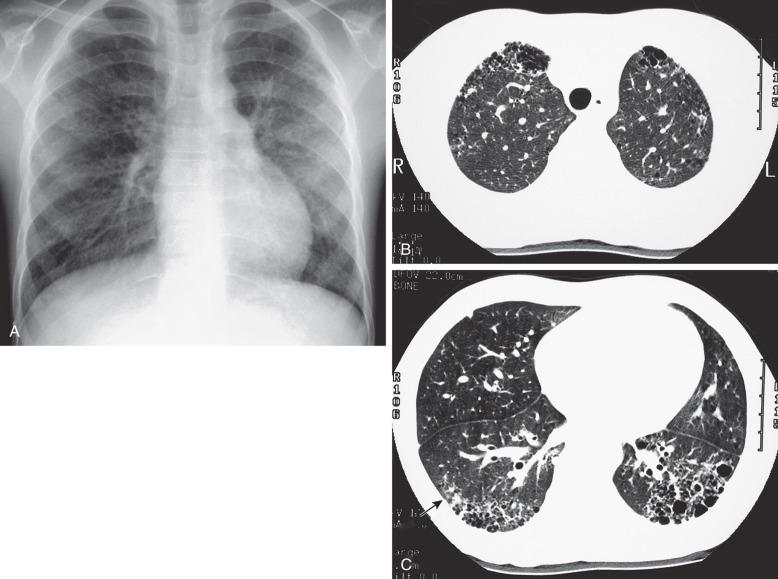
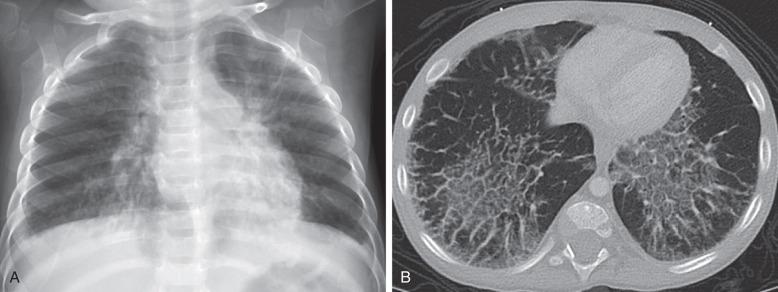
Treatment for the vasculitides and CVDs is primarily aimed at suppressing the immune response, typically with corticosteroids and chemotherapeutic agents, as well as newer biologic drugs when appropriate.
Patients who develop diffuse alveolar hemorrhage often show evolving changes on CT follow-up. A more linear and interstitial type of pattern may develop with interlobular septal thickening and the appearance of the crazy paving pattern. If episodes of hemorrhage recur, this may also progress to interstitial fibrosis. Pulmonary involvement with CVD may progress to interstitial pulmonary fibrosis regardless of treatment, with advanced stages showing honeycombing. Pulmonary artery hypertension may also develop with advanced lung disease, especially in systemic sclerosis and systemic JIA.
Follow-up imaging is primarily determined by clinical needs, symptoms, or both. Follow-up chest radiograph can be helpful but CT is more likely to show subtle changes. Progression of abnormal PFTs in patients with juvenile systemic sclerosis over time correlate with worsening of changes on CT, suggesting that PFTs could potentially be used as a marker to determine when follow-up CT may be needed.
Acute chest syndrome (ACS), an illness that occurs in up to 50% of children with sickle cell disease (SCD), is characterized by chest pain, leukocytosis, fever, and a new pulmonary opacity. It is a primary cause of death and hospitalization in all patients with SCD and in children usually occurs between 2 and 4 years of age. ACS also occurs in patients with other sickle hemoglobinopathies. When not fatal, it may lead to chronic lung disease (4%) and pulmonary hypertension.
The etiology of ACS is complex and not always known. In a large multicenter study, established causes were microvascular occlusion and infarction (16%), infection (29%), fat emboli from bone marrow infarcts (9%), and unknown in 46%. Chlamydia, Mycoplasma, and viral agents were the most common pathogens in cases caused by infection. One-third of patients presented with symptoms of long bone pain caused by vasoocclusive crisis and developed ACS 2 to 3 days later.
Radiographic findings of ACS by definition include the presence of a pulmonary opacity ( e-Fig. 57.5 ) but are otherwise nonspecific. Opacities were noted in the lower lobes in about 90%, and pleural effusion was noted in 55% of patients in a large multicenter study (see Table 57.1 ).
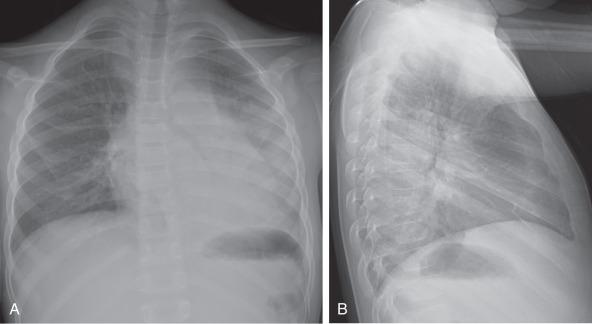
Although CT is not generally used in the setting of ACS, chronic sickle cell lung disease has been studied. Abnormal findings are most pronounced at the lung bases and include parenchymal bands, interlobular septal thickening, architectural distortion, and traction bronchiectasis. Honeycombing is unusual, in contrast to other types of pulmonary fibrosis.
Therapy for ACS includes hydration, analgesia, respiratory support (including bronchodilators), broad-spectrum antibiotics, transfusion therapy, and sometimes corticosteroids. Imaging follow-up is primarily dictated by clinical course and usually only requires radiography.
Langerhans cell histiocytosis (LCH) is the preferred term for the condition showing a proliferation of a group of histiocytes known as Langerhans cells . Langerhans cells are of myeloid dendritic cell origin and contain characteristic Birbeck bodies on histology. The peak age at initial diagnosis is 1 to 3 years, and most patients present with osseous lesions. LCH is currently classified according to the extent of involvement, whether it involves a single site (better prognosis) or multiple sites (higher risk of long-term problems). The involvement of “risk organs” (bone marrow, liver, or spleen) indicates a poorer prognosis and demands more aggressive treatment.
Pulmonary involvement is reported to be present in 10% of all patients with LCH and 23% to 50% of children with multisystem LCH, with a mean age of 11.9 months in one study. Disease-free survival in these patients was 69%, with 3 out of 4 deaths occurring when “risk organs” other than the lung were involved. Although lung disease was traditionally considered a poor prognostic indicator in LCH, recent studies have shown that it does not adversely affect outcome. Primary pulmonary LCH (single site) is rare in children and is typically seen in young adult smokers.
The etiology of LCH is not known. Most investigators believe it to be an immune-mediated condition, in which the Langerhans cells accumulate and cause an inflammatory reaction. In the lungs, destructive granulomatous lesions occur in the interstitial tissues, bronchial and bronchiolar epithelium, and subpleural septa and may eventually lead to cystic lesions. Pulmonary fibrosis occurs later in 10% of children.
Radiologic findings of LCH vary widely with the extent of the disease and are summarized in Table 57.1 . The initial chest radiograph may be normal. Small nodules and cysts may be seen, with upper lobe involvement equal to or more extensive than lower lobe involvement ( Fig. 57.6 ). The reticular appearance noted on a chest radiograph is often from multiple small cysts. LCH is the most common cause of acquired extensive cystic lung disease in children ( e-Fig. 57.7 ). Spontaneous pneumothorax is reported to occur in about 11% of patients with pulmonary involvement and may be the first indicator of pulmonary disease. However, it may also be a manifestation of more advanced disease, as in adolescents who more often have large coalescent cysts (see e-Fig. 57.7 ).
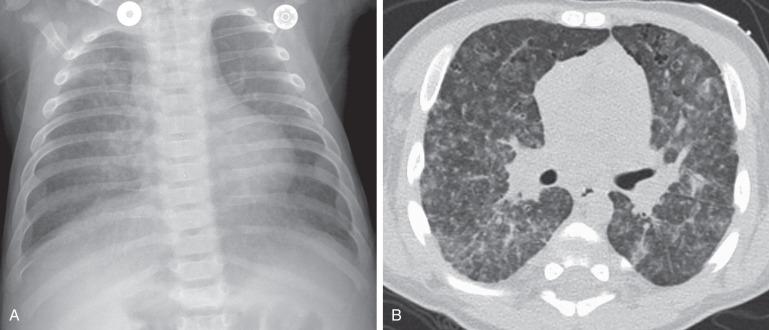
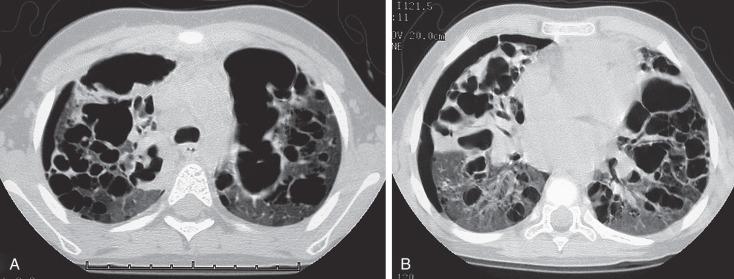
CT is indicated for neonates with LCH and any patient with abnormalities on the chest radiograph. CT findings in LCH are characterized by small nodules (with or without cavitation) with upper and middle lobe predominance (see Fig. 57.6 ). The pulmonary late-stage disease shows interstitial thickening and cystic spaces of variable diameter (see e-Fig. 57.7 ). The pleura may be thickened and sometimes replaced by a thick layer of granulomatous tissue. However, pleural effusions are rare. Mediastinal and hilar adenopathy is also rare in children with pulmonary LCH.
Treatment of pulmonary LCH depends on the extent of disease and whether “risk” organs are involved. Generally, the first line of treatment is corticosteroids, vinblastine, or both, with duration of therapy being determined by response. Radiation therapy has fallen out of favor except for treating unstable bone lesions. Imaging follow-up for pulmonary LCH depends on clinical symptoms. If abnormalities were present on initial chest radiographs, radiographs can be used for follow-up with CT reserved for progression and/or problem solving.
These two lysosomal storage disorders have a wide range of pathologic expression in different organ systems most frequently affecting the bone marrow, liver/spleen and/or central nervous system, and rarely affecting the lung parenchyma. Gaucher disease is more common than Niemann–Pick. Gaucher neuronopathic type 3 is more likely to affect the lung than is Niemann–Pick type B.
Both of these disorders are transmitted by an autosomal recessive inheritance pattern and genetic mutations have been identified for all types. Gaucher disease is caused by a deficiency of the enzyme glucocerebrosidase that results in an accumulation of the lipid glucocerebroside in phagocytic cells, so-called Gaucher cells. Niemann–Pick disease is caused by a deficiency of sphingomyelinase, resulting in accumulation of the lipid sphingomyelin in the Niemann–Pick cells. These lipid-laden “foamy” macrophages deposit in various tissues, and may infiltrate the lung causing pulmonary symptoms. Niemann–Pick disease has been associated with endogenous lipoid pneumonia in several patients and was the presenting condition in three adult patients
Both Gaucher and Niemann–Pick disease cause a diffuse reticulonodular pattern on chest radiographs. CT abnormalities have also been described in both, including ground-glass opacities, areas of consolidation, and interstitial thickening ( Fig. 57.8 ). Mediastinal findings of lymphadenopathy and thymic enlargement are also reported in Gaucher disease. Niemann–Pick type C2 occurs in infants and has been reported to cause a crazy paving pattern on CT ( e-Fig. 57.9 ).
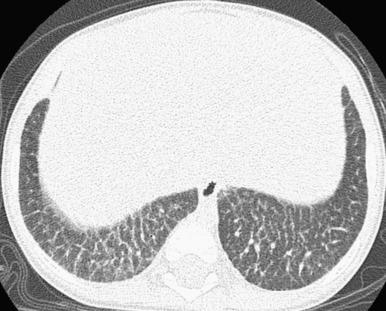
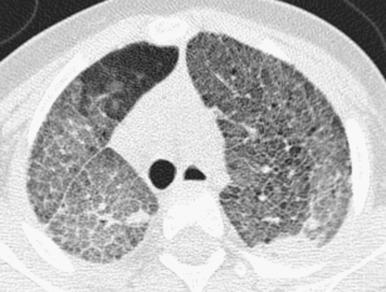
Visceral involvement may improve with enzyme replacement therapy in Gaucher disease, and this therapy may offer an alternative to lung transplantation. The current treatment for Niemann–Pick disease with pulmonary involvement is whole lung lavage. Regarding follow-up imaging, chest radiographs have been recommended every 2 years for patients with Gaucher disease to monitor the lungs. In the setting of known pulmonary involvement, CT follow-up would be more sensitive than plain radiography for subtle changes if clinically needed.
Pulmonary edema is the excessive accumulation of water and solute in the lung tissues. Functionally, pulmonary edema is divided into two general categories: (1) those cases having elevated pulmonary venous pressure (cardiogenic or hydrostatic) and (2) those associated with increased capillary permeability with normal microvascular pressure (noncardiogenic). Pulmonary edema may also have mixed etiologies, and sometimes the actual mechanism is unknown. Cardiogenic pulmonary edema is far less common in children than in adults.
In children, cardiogenic edema usually occurs in infants less than 6 months of age as the result of congenital heart disease (CHD) such as left-to-right shunting lesions, left ventricular outlet obstruction, or obstruction of pulmonary venous return ( Fig. 57.10 ). Affected infants often present with nonspecific symptoms, including feeding difficulties, grunting, diaphoresis, wheezing, and retractions. Rarely, pulmonary edema may be the presenting manifestation of CHD. In an older child, cardiomyopathy is the usual cause of cardiogenic edema ( e-Fig. 57.11 ).
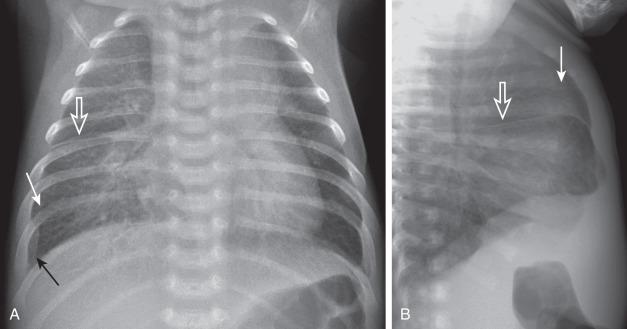
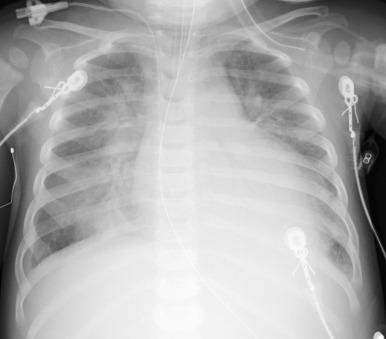
Become a Clinical Tree membership for Full access and enjoy Unlimited articles
If you are a member. Log in here